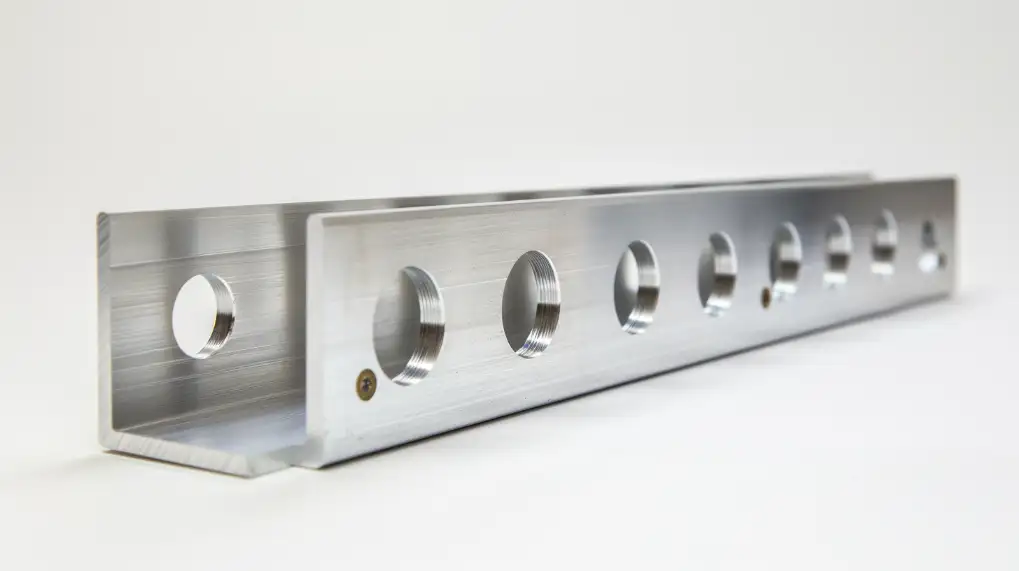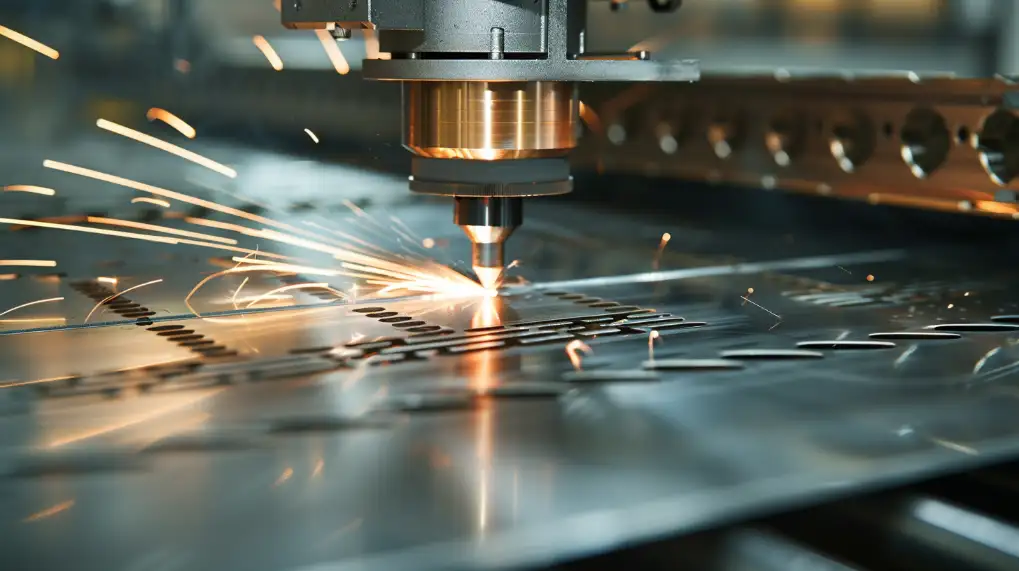Aluminum sheet is popular in many industries because it is lightweight, strong, and corrosion-resistant. But cutting it the wrong way can lead to rough edges, warping, or wasted material. If you’re working with aluminum sheet metal for the first time, you might feel unsure about which cutting method to choose.
You can cut aluminum sheet metal using hand tools or machines. For small projects, tools like tin snips or a jigsaw work well. For clean, fast cuts on large jobs, use a shear, laser cutter, or CNC machine. The right method depends on your sheet thickness, volume, and accuracy needs. Always secure the sheet and wear safety gear before cutting.
Different tasks require different cutting techniques. Read on to find the right tool and method for your aluminum project.
Knowing Aluminum as a Material
Before you cut aluminum, you need to know what you’re working with. Different types and forms of aluminum react differently when cut. Some are soft and easy to slice. Others are tough and require more force or better tools.
Properties of Aluminum That Affect Cutting
Aluminum is lightweight and softer than steel. It bends easily under pressure, making it easier to cut but also easier to deform if not handled correctly.
It has high thermal conductivity. Friction from cutting can heat it fast. That may cause the metal to expand or clog tools.
It forms a thin oxide layer. That layer protects it from corrosion but can make the first cut slightly harder.
Some aluminum grades are harder than others. The harder the metal, the harder it is to cut cleanly.
Types of Aluminum Alloys and Their Cutability
Aluminum comes in many alloys. Each alloy has its strength and cutting behavior.
- 1000 series: Pure aluminum. Very soft and easy to cut. Not strong.
- 3000 series: Good corrosion resistance. Easy to cut with most tools.
- 5000 series: Stronger. Still good for cutting with shears and saws.
- 6000 series: Harder. Needs better tools or more power.
- 7000 series: Very strong. Best cut using CNC or laser tools.
Sheet, Plate, Tube, and Bar: Know Your Aluminum Form
Aluminum is sold in many forms. Each needs a different approach.
- Sheet: Thin and flexible. Use snips, shears, or lasers.
- Plate: Thick and rigid. Needs saws, mills, or plasma.
- Tube: Hollow and round. Use a tube cutter or fine-tooth saw.
- Bar: Solid and strong. Bandsaws or mills work best.
Preparing for the Cutting Process
Preparation is key before cutting. Taking a few steps upfront helps prevent mistakes and protects your tools. It also leads to better, cleaner cuts with less rework.
How to Select the Right Aluminum Grade?
Pick the grade based on your project needs.
- For bending or forming, choose softer grades like 1100 or 3003.
- For structural parts, go with stronger grades like 5052 or 6061.
- For welding, avoid the 7000 series. They can crack easily.
Cleaning and Marking the Aluminum Before Cutting
Clean the aluminum before marking. Dirt, oil, or metal shavings can affect accuracy or clog your blade. Use a clean cloth and rubbing alcohol to wipe down the surface.
Mark your cut lines with a fine-tip marker or scribe. Make sure the lines are visible, straight, and easy to follow. Double-check your measurements. A small error here can waste material later.
Clamping and Positioning for Stability
Secure the sheet before cutting. Loose metal can shift and ruin the cut. It can also damage your tool or cause injury.
Use clamps or a vice to hold the aluminum in place. For thin sheets, place a backing board underneath to reduce vibration.

Manual Cutting Methods
Manual tools are great for small jobs, simple cuts, or thin aluminum sheets. These tools are easy to use, don’t need power, and are ideal when precision is less critical.
Hacksaws
A hacksaw is simple and affordable. It works best on small bars, rods, or thin sheets.
Use a fine-tooth blade made for non-ferrous metals. Clamp the material tightly. Cut with steady, even strokes. Don’t rush or force it.
The downside is a slower cutting speed and more physical effort, but it’s a good choice when working in tight spaces.
Utility Knives
You can score and snap thin aluminum sheets with a utility knife.
Place the sheet on a flat surface. Use a ruler and make several deep score lines. Then, bend the sheet along the score until it breaks.
This method works best for sheets under 1mm thick. It’s quick, clean, and quiet, and no power is needed.
Metal Shears
Metal shears are like heavy-duty scissors. They work well for soft aluminum up to 16 gauge.
There are hand shears, compound snips, and aviation snips. Choose the type that matches your cut style—straight, left, or right.
They’re fast and easy to control. But edges can curl or warp if you’re not careful. Always cut slowly and support the metal as you go.
Power Tool Cutting Methods
Power tools help cut faster and cleaner, especially for thicker aluminum or higher volumes. With the right setup, they can save time and reduce effort.
Using a Jigsaw with Aluminum Blades
A jigsaw works well for curves or irregular shapes. Use a blade designed for metal. Look for fine teeth and a high tooth count. Clamp the sheet firmly and cut at medium speed.
Let the blade do the work. Don’t push too hard, or you might bend the sheet or break the blade. Add a bit of cutting fluid to keep things cool and prevent clogging.
How to Cut Aluminum with a Circular Saw?
A circular saw cuts straight lines in thick aluminum sheets or plates. Use a carbide-tipped blade made for non-ferrous metals, and set the blade depth just past the material thickness.
Secure the sheet and feed the saw slowly. Wear safety gear—aluminum chips fly fast. To reduce heat and friction and achieve smoother cuts, apply cutting wax or lubricant.
Reciprocating Saws
Reciprocating saws are great for rough cuts or demolition work. Use a metal-cutting blade with fine teeth. Clamp the aluminum to keep it steady.
Move the saw slowly and let the blade do the cutting. This tool is best for thick bars, tubes, or scrap metal. It is not ideal for precision, but it is useful when accuracy isn’t critical.
Router Cutting
Routers are good for cutting slots, holes, or complex profiles. Use aluminum carbide-tipped bits. Run the tool at lower speeds to avoid overheating.
Clamp the material and use a straight edge to guide the router. Always wear eye protection. Chips can be sharp and hot. Apply lubricant to improve the cut and extend the tool’s life.
Workshop Equipment and Machinery
Workshop machines offer more control for high volumes, tight tolerances, or thick materials. These tools provide clean, repeatable cuts and save time on larger jobs.
Band Saws
Band saws are good for cutting aluminum bars, plates, and tubes. Use a bi-metal blade with fine teeth. Adjust the speed to match the aluminum thickness. Slower speeds help reduce heat.
Support the material with a flat table or roller stand. Keep the blade straight to avoid angled cuts. Band saws are reliable and quiet. They work well for both straight and curved cuts.
Cold Saws
Cold saws use a circular blade and coolant system to keep aluminum cool while cutting. They make very clean cuts with no burrs. Perfect for tight tolerance parts.
Use a blade designed for aluminum. Secure the material tightly and let the saw feed slowly through it. Cold saws are ideal for production jobs where finish quality matters.
Miter Saws
Miter saws are great for cutting aluminum extrusions, angles or tubes. Install a non-ferrous metal blade with carbide tips. Set the correct angle and clamp the material firmly.
Cut slowly and smoothly. Use cutting wax or fluid to reduce heat and extend blade life. Miter saws are quick, easy to adjust, and great for repeatable cuts.
CNC Machines
CNC machines are the top choice for precision work and high-volume production. They can handle complex shapes, tight tolerances, and any aluminum grade.
Use sharp-end mills or aluminum cutting tools. Set the right feeds and speeds to avoid tool wear. CNC machines provide unmatched accuracy. They also reduce scrap and help standardize parts across batches.
Advanced Cutting Technologies
When precision, edge quality, or material thickness matter most, advanced cutting methods step in. These technologies offer clean results with minimal heat or distortion.
Waterjet Cutting
Waterjet uses high-pressure water mixed with abrasive grit to cut aluminum without heat. It works on thick or thin sheets and leaves a smooth edge. There’s no heat-affected zone, so the metal stays stable.
It’s great for complex shapes, tight tolerances, or materials that can’t handle heat. It’s slower than a laser but more versatile with thickness.
Laser Cutting
Laser cutting uses focused light to melt and cut aluminum. It’s best for thin to medium sheets. Cuts are fast, clean, and precise. Perfect for detailed parts or high-volume jobs.
To improve the edge, use the right laser power and assist gas (like nitrogen or oxygen). Aluminum reflects heat, so fiber lasers work better than CO2 types.
Plasma Cutting
Plasma cutting uses a jet of ionized gas to melt and blow away metal. It’s faster than oxy-fuel and works well for medium to thick aluminum sheets.
Edges may need cleanup. Plasma is not as precise as laser or waterjet, but it’s affordable and fast for rough cuts. Use dry air or an argon-hydrogen mix for best results. Wear protective gear—plasma is loud and bright.

Tips for Optimal Aluminum Cutting Performance
Cutting aluminum can be smooth and efficient when you follow a few key tips. These practices help extend tool life, reduce heat, and improve the cut finish.
Lubricate the Blade
Always use a lubricant when cutting aluminum. It reduces friction and prevents the metal from sticking to the blade. Use cutting wax, oil, or a mist coolant system. Apply it directly to the blade or workpiece before and during the cut.
Aluminum Cutting Speed and Pressure
Use slower speeds than you would for wood or plastic. Aluminum heats up fast. Too much pressure leads to rough edges and blade damage. Fine-tooth blades at a steady speed give smoother results.
Cooling Techniques
Cutting generates heat. Without cooling, aluminum expands or clogs the blade. Use compressed air, mist coolant, or liquid coolant to lower the temperature. This also keeps chips out of the cut path.
The Smaller the Blades, the Better
Smaller diameter blades spin faster and give more control. They also reduce vibration and improve the finish. When cutting thin sheets with circular saws or routers, choose smaller blades. Match blade size to material thickness.
Clamp the Workpiece
Always secure the aluminum before cutting. A shifting sheet can ruin the cut or cause injury. Use clamps, vices, or backing boards. For thin sheets, sandwich the material between wood panels to keep it flat.
Conclusion
Cutting aluminum sheet metal depends on the material type, thickness, and the level of precision you need. Use the right blade, cutting speed, and cooling method. Always clamp the aluminum securely and apply lubricant to get clean, safe, and efficient results.
Need help with aluminum cutting for your project? We support both prototyping and full-scale production with precision cutting services. Let us know your specs, and we’ll help you get it done right—fast and at the right cost. Contact us now to get a quote.
More Resources:
Cutting fluid – Source: Wikipedia
Clamping Techniques for Metal Cutting – Source: Rong Fu
Hey, I'm Kevin Lee

For the past 10 years, I’ve been immersed in various forms of sheet metal fabrication, sharing cool insights here from my experiences across diverse workshops.
Get in touch

Kevin Lee
I have over ten years of professional experience in sheet metal fabrication, specializing in laser cutting, bending, welding, and surface treatment techniques. As the Technical Director at Shengen, I am committed to solving complex manufacturing challenges and driving innovation and quality in each project.




